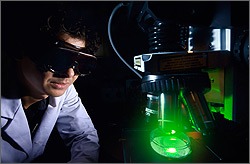By: Dr. John Kyndt ( Head Scientist of the Renewable Energy Program at Advanced Energy Creations Lab)
 In previous blogs (Developing GE Thermophilic Bacteria for Syngas to Fuel Conversion) we mentioned the potential of syngas production from algae and LEA, and its conversion to fuel using thermophilic bacteria.
In previous blogs (Developing GE Thermophilic Bacteria for Syngas to Fuel Conversion) we mentioned the potential of syngas production from algae and LEA, and its conversion to fuel using thermophilic bacteria.
An alternative to the bacterial syngas conversion is the chemical conversion of syngas to ethanol, diesel, gasoline and even jetfuel analogues. Using chemical conversion these fuels fall under the category of ‘green fuels’ rather than biofuels.
In this set-up, the syngas is converted over a chemical catalyst in a flat bed reactor at an optimized temperature and pressure. The catalyst used depends on the desired fuel type, however all catalysts used today have significant drawbacks at the level of cost efficiency, catalytic efficiency and undesired byproduct formation.
Further R&D is therefore necessary to develop new chemical catalysts to make either of these approaches economically feasible.
1) Syngas to green ethanol catalysis:
- The catalytic conversion of syngas to ethanol is thermodynamically favorable at temperatures roughly below 350 °C and at 30 bar. However one of the major byproducts from the reaction is methane, which, when allowed to form, extremely limits the ethanol yield. Therefore, several types of catalysts are used to gear the reaction towards high ethanol yield. Rhodium (Rh) based catalysts give the best ethanol selectivity (albeit at low CO conversions). The major drawback of Rh catalysts is their high cost.
2) Syngas to green diesel catalysis:
- The typical reaction used for the conversion of CO and H2 to liquid hydrocarbons is the Fischer-Tropsch process. This reaction forms synthetic petroleum substitutes (like diesel) using cobalt (Co) or iron (Fe) based catalysts. Generally the catalysts are supported on a silica or alumina oxide solid phase and ‘promoters’ (like K or Cu) are added. The Fisher-Tropsch catalysts are notoriously sensitive to the presence of sulphur containing compounds among other toxins, which kills the reaction.
3) Syngas to green gasoline catalysis:
- In this process, syngas is made to produce dimethyl ether, which is turned into gasoline at temperature of about 200-300 °C. The catalysts are typically copper (Cu) or zinc (Zn) based, on aluminia or titania solid phases, with the addition of a dehydration catalyst. However there is need for improvement in the productivity, heat transfer, reactor scale and other significant parameters that can lead to cost efficiency. There is also need for more versatility in the starting gas composition.
There is room and need for further improvement of each type of these catalysts to guaranty larger, commercial scale success. Scientists at various universities and research institutes around the world are therefore developing and testing new chemical catalyst for the syngas conversion.
This is typically done based on modifications of the existing catalysts, but innovative new chemical catalysts are also being designed and tested on a lab scale level.
A systematic experimental study of the catalytic synthesis of these green fuels from syngas is necessary, always with cost efficiency and scalability in mind. The quality and composition of the feedstock (algae in our case) is also an important factor in the design and lifetime of the novel catalysts.
There are pros and cons to both the chemical and biological way to syngas conversion and currently the lead is held by chemical conversion. However if the costs of catalysts cannot be reduced, biological conversion will soon become a very attractive alternative.


